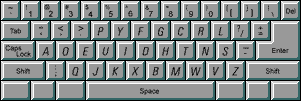Well, for my first opinion lets talk about the living horror that is the qwerty keyboard layout. You know the one, it's staring you in the face right now. It sucks. It's intentional. It's fixable. The really sad part is that few people know that they do have other options, and those that do are usually to complacent to do anything about it. I'll bet that most typing teachers (if there are any anymore) don't know that there are other choices. If you use windows, it's just a couple of mouse clicks to change your keyboard layout. The truth is that any computer can be reconfigured fairly easily. The best alternative is the Dvorak layout, and it's already on your computer.

Let's say you can only use one hand (or only want to use one hand) there is a left hand only and a right hand only layout, you guessed it, already on your computer. Here's how...Start menu; Control Panel; Keyboard; Language; Properties ... then choose a layout and click "OK" a couple of times to finish. Now for a little history.
Early Typewriter History
The first practical typewriter was invented by Christopher Latham Sholes, and was marketed by the Remington Arms company in 1873. The action of the type bars in the early typewriters was very sluggish, and tended to jam frequently. To fix this problem, Sholes obtained a list of the most common letters used in English, and rearranged his keyboard from an alphabetic arrangement to one in which the most common pairs of letters were spread fairly far apart on the keyboard. Because typists at that time used the "hunt-and-peck" method, Sholes's arrangement increased the time it took for the typists to hit the keys for common two-letter combinations enough to ensure that each type bar had time to fall back sufficiently far to be out of the way before the next one came up. Note that Sholes hadn't imagined that typing would ever be faster than handwriting, which is usually around 20 words per minute (WPM) or less.
Around 1878, ten-finger typing, promoted by Mrs. L. V. Longley, the head of a Cincinnati school for stenographers, started to replace two-finger typing. Later, Frank E. McGurrin, a federal court clerk in Salt Lake City, taught himself to touch-type without looking at the keys. When McGurrin won a highly publicized typing contest between himself and Louis Taub of Cincinnati (both of whom claimed to be the "world's fastest typist"), touch-typing began to catch on.
Although typists' speeds quickly surpassed the one- and two-finger speeds achieved by early typists on the original alphabetic keyboards, the actions on the newer typewriters kept improving to keep up, and the jamming problem did not recur. Sholes himself was granted a patent on an improved keyboard arrangement in 1896. However, then as now there was widespread belief in the myth that the benefits of retraining typists were not worth the costs, and to this day the qwerty keyboard layout has remained the industry standard.
Reference R. C. Cassingham, The Dvorak Keyboard, (Arcata, California: Freelance Communications, 1986; ISBN: 0-935309-10-1), pp. 21-24, 27.
Links